The Top Benefits of AI in Customer Service

Chris Raroque
Co-Founder

Share to AI
Ask AI to summarize and analyze this article. Click any AI platform below to open with a pre-filled prompt.
Customer service is undergoing an overhaul due to AI. The benefits of AI in customer service go from personalization and 24/7 customer support to cost management and maintaining the productivity of the customer service team as a whole.
At Aloa, we build customer service experiences that not only drive customer satisfaction but also solve complex issues at scale. We’re up to speed on the latest in AI-driven customer service, allowing us to build chatbots that always provide relevant responses to customer issues, CRMs that turn customer feedback into actionable insights, and more.
In this comprehensive guide, we’ll cover how AI is reshaping customer service, including:
- The tangible benefits of AI in customer service
- AI-enabled personalized experiences at scale
- Proven implementation strategies
- What the future holds for AI-driven customer service
Whether you're looking to scale efficiently, improve customer satisfaction scores, or simply keep pace with evolving customer expectations, understanding these benefits of AI in customer service is your first step toward sustainable competitive advantage.
Key Benefits of AI in Customer Service
The main benefits of AI in customer service operations hinge on AI’s capability to process vast amounts of data in a short time, and new NLP capabilities that open up all-new pathways for personalization and customer engagement.
Automating Routine Tasks
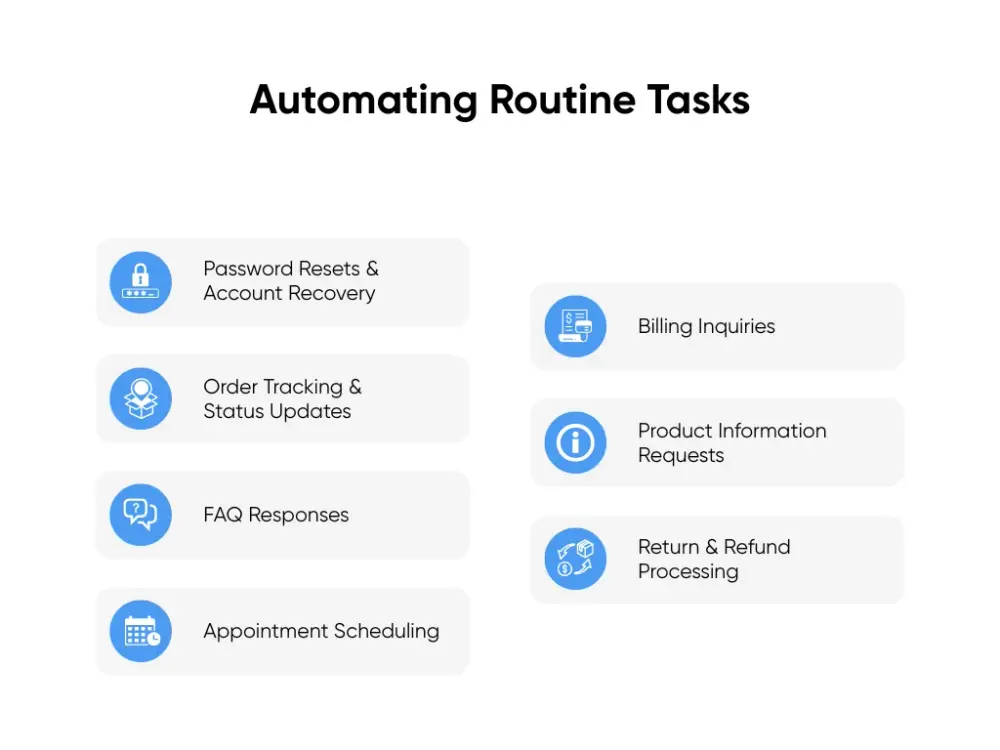
AI has a long way to go before it can reason on the level of human customer service agents. But it does excel at repetitive work:
- Password resets and account recovery: Bank of America's Erica handles millions of password reset requests monthly, completing each in under 30 seconds compared to 5-minute human interactions.
- Order tracking and status updates: Amazon's AI processes 85% of order inquiries automatically, providing real-time tracking without agent involvement.
- FAQ responses: H&M's chatbot resolves 70% of customer queries about sizing, returns, and shipping policies without escalation.
- Appointment scheduling: Healthcare providers using AI scheduling report 60% reduction in administrative time while handling 3x more bookings. Aloa’s healthcare AI solutions achieve similar results.
- Billing inquiries: Telecommunications companies automate 75% of billing questions, from explaining charges to processing payment arrangements.
- Product information requests: Best Buy's AI assistant handles technical specifications and compatibility questions across 100,000+ SKUs instantly.
- Return and refund processing: E-commerce platforms automate return authorization for 80% of cases that meet standard criteria.
All of this is done without human intervention. AI agents like Zendesk’s claim to be able to automate up to 80% of such interactions.
Providing 24/7 Support
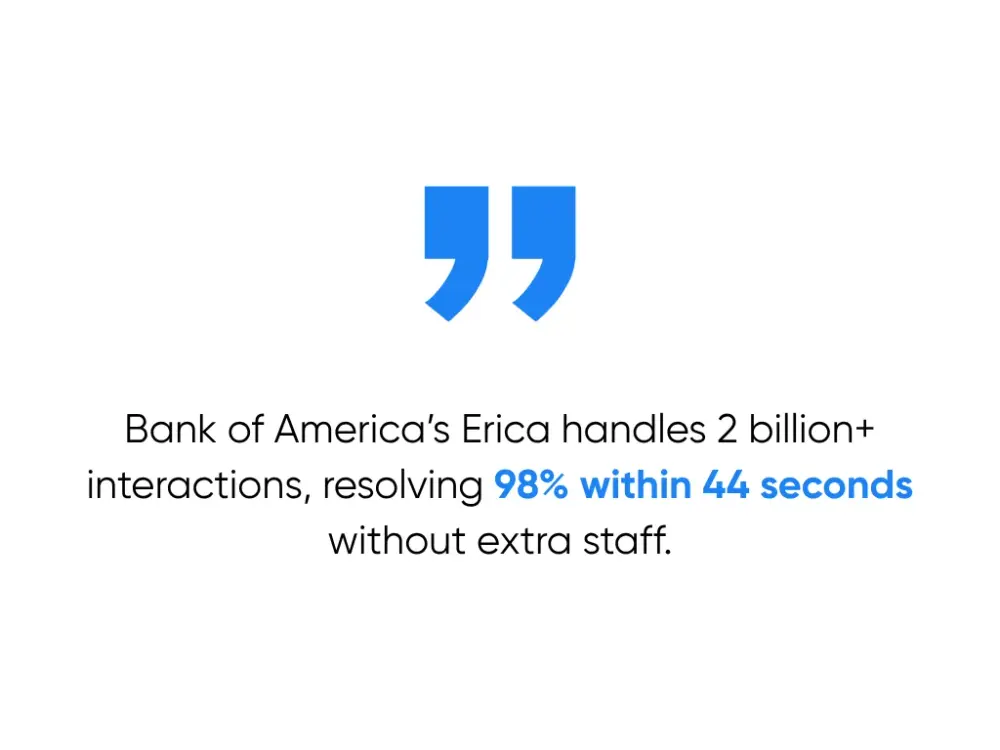
Customers have come to expect round-the-clock availability even before the AI revolution, but with AI, meeting that expectation has become almost trivial.
Bank of America's Erica manages 2 billion+ interactions, serving 42 million clients without adding staff. BofA’s solution proves that 98% of AI interactions can be resolved within as little as 44 seconds. By contrast, the average human response time can be anywhere from 2 to 11 minutes. These speed and quality benefits have led to 62% of customers preferring AI chatbots for simple queries rather than waiting for human agents, reports Salesforce.
Aloa's finance AI solutions enable financial institutions to achieve this same instant-response capability through AI-powered virtual assistants and chatbots that automate customer support, claims processing, and inquiries around the clock, ensuring customers get immediate help whether it's handling routine banking queries or processing transactions.
Advanced Personalization
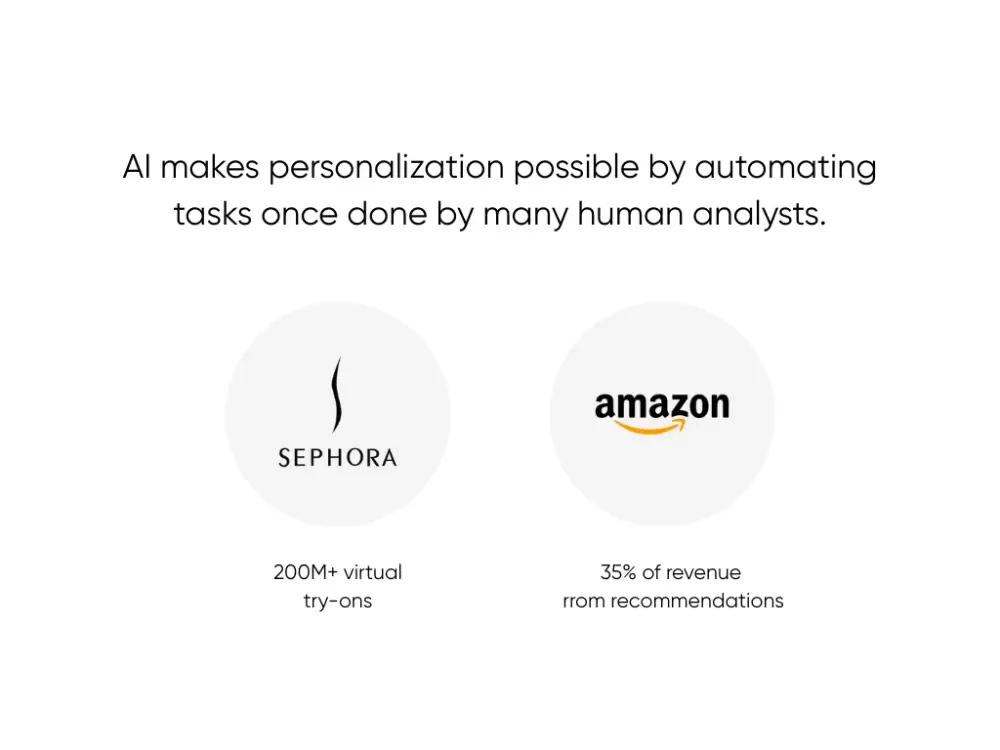
Personalization at scale once required enormous resources, but AI makes it accessible to businesses of any size. Using advanced data processing capabilities, AI can analyze the transaction history, preferences, and behavior patterns of thousands of customers in real time.
Here are some great examples of AI’s personalization power:
- Sephora's Virtual Artist feature: Has facilitated over 200 million virtual shade try-ons. Their implementation can remember every interaction, purchase, and preference, creating an experience comparable to having a dedicated beauty consultant who knows each customer intimately.
- Amazon’s recommendation engine: Drives a reported 35% of total revenue by anticipating customer needs before they’re expressed. Their implementation analyzes vast amounts of data to correlate interest groups and predict what customers next based on what people with similar interests have searched.
Personalized experiences increase customer lifetime value by 20-30% on average. When customers feel understood and valued, they spend more, return more frequently, and become brand advocates. AI makes this level of personalization economically viable by automating what would require armies of human analysts to achieve manually.
Reducing Operational Costs
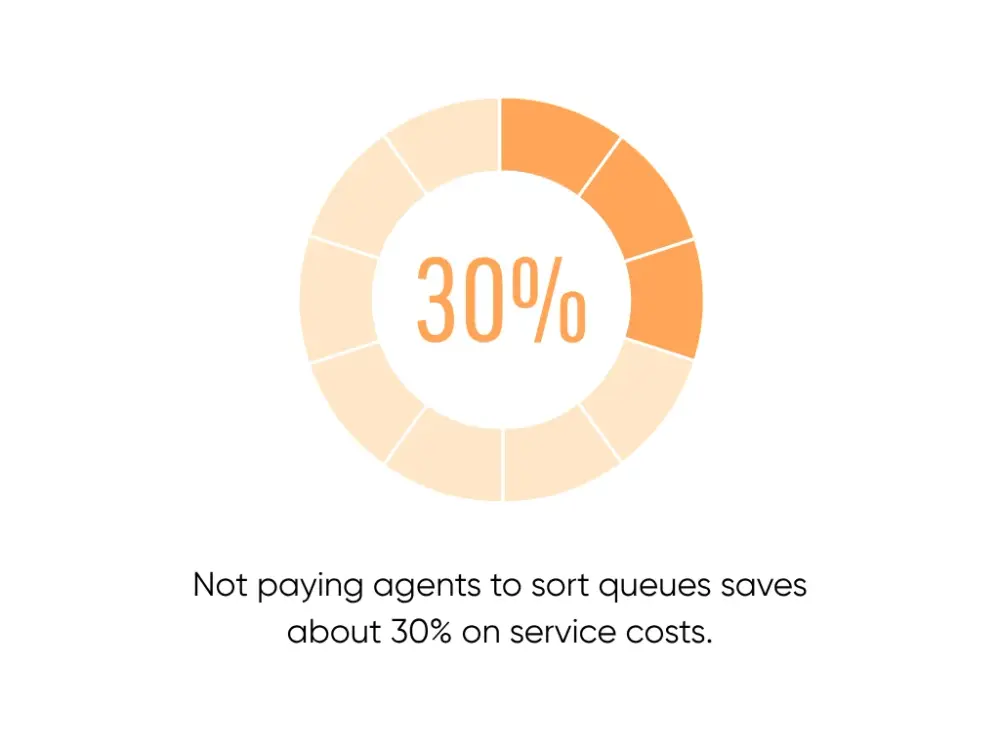
Automating routine tasks has a direct impact on your bottom line. Since you’re not paying for your agents to manually sort through queues, you can save an average of 30% on customer service costs. Human-handled customer conversations average $8 per interaction, while AI-powered interactions cost just 10 cents.
AI also works wonders for scalability. While traditional support costs increase linearly with volume, AI-powered systems can scale exponentially with minimal overhead increase.
Klarna’s AI assistant is a great example of this in practice. Powered by OpenAI, the assistant handles work equivalent to 700 full-time agents, driving $40 million in projected annual profit improvement. The system also resolves customer inquiries in under 2 minutes on average, compared to 11 minutes for human agents.
Boosting Agent Productivity
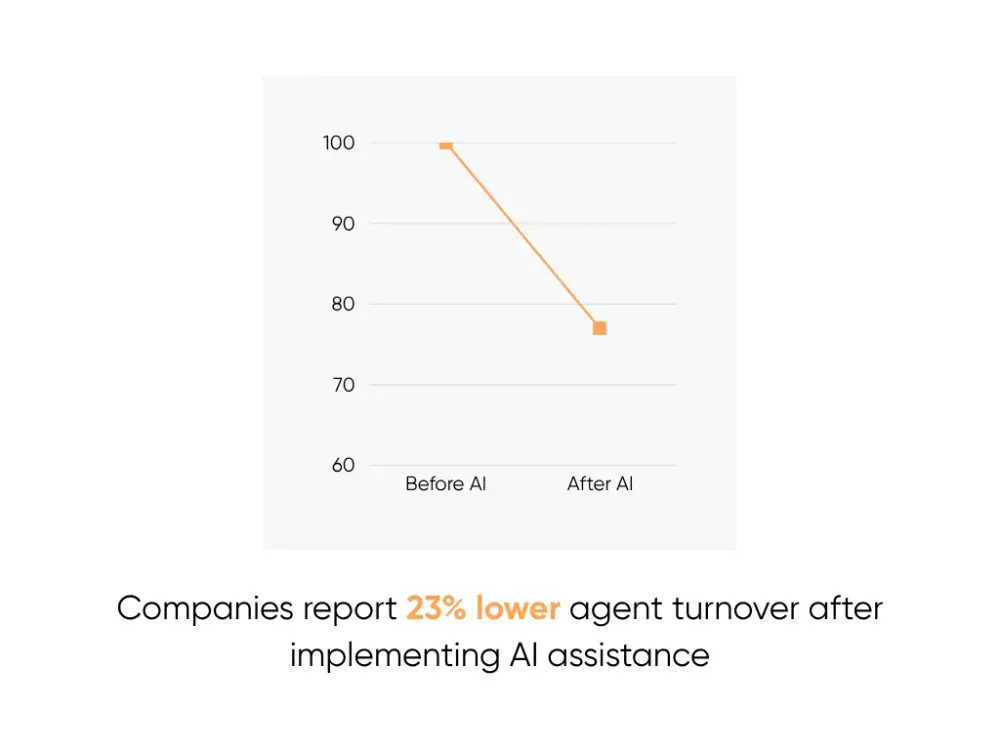
Research from Stanford and MIT shows agents using AI handle 13.8% more inquiries per hour, with newer agents seeing productivity gains up to 34% as AI helps them perform like veterans.
The productivity boost comes from AI eliminating time-wasting activities. Instead of agents manually searching through knowledge bases or entering data, AI instantly surfaces relevant information and automates administrative tasks, which could save 2-3 hours daily per person.
The productivity benefits of AI also help employee satisfaction and morale. Companies report 23% lower agent turnover after implementing AI assistance. This brings substantial savings on recruitment and training costs.
Strategies for Successful AI Implementation
The most successful implementations start with clear objectives centered around positioning AI as a force multiplier for human support representatives. Proceed through these phases carefully:
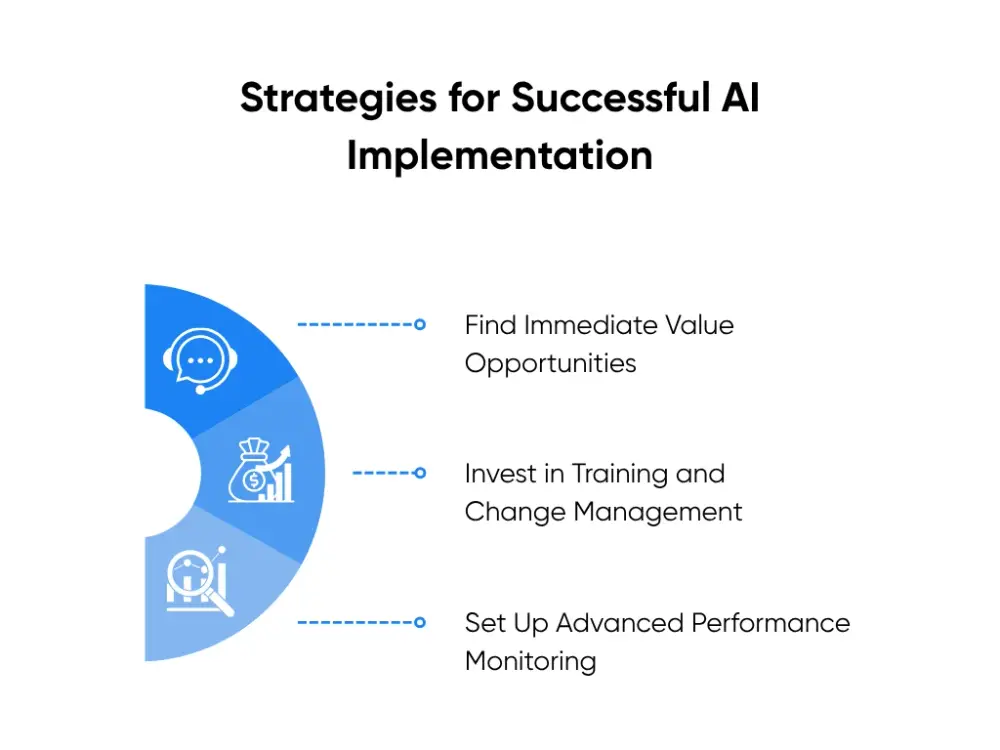
Find Immediate Value Opportunities
Begin by mapping your current customer service processes to identify where AI can deliver the most immediate value. Focus on high-volume, repetitive tasks that consume significant agent time but require minimal human judgment.
Common starting points include FAQ automation, ticket routing, and initial customer authentication. Run pilot programs for 30-60 days with specific success metrics like deflection rate, resolution time, and customer satisfaction scores.
Invest in Training and Change Management
Invest at least 40-60 hours in comprehensive training that goes beyond technical skills to address the why behind AI implementation. This helps agents understand how AI makes them more effective, and thus how best to use it.
Create AI champions within your team who can provide peer support and share success stories. Address resistance openly, acknowledging concerns while demonstrating concrete benefits through pilot results.
Set Up Advanced Performance Monitoring
Performance monitoring must evolve to include AI-specific metrics. Track deflection rates to measure what percentage of inquiries AI resolves without human intervention.
Monitor escalation patterns to identify where AI struggles and needs improvement. Customer satisfaction for AI and human interactions should be measured separately to ensure sanity throughout. Regular analysis of these metrics enables continuous optimization, helping your AI system learn and improve over time.
Aloa's approach to AI implementation emphasizes risk mitigation through proof-of-concept development. Our 2-week POC process validates AI solutions with your actual data before full-scale deployment. This methodology has helped over 250 clients across multiple industries successfully implement AI while avoiding common pitfalls.
Future Prospects of AI in Customer Service
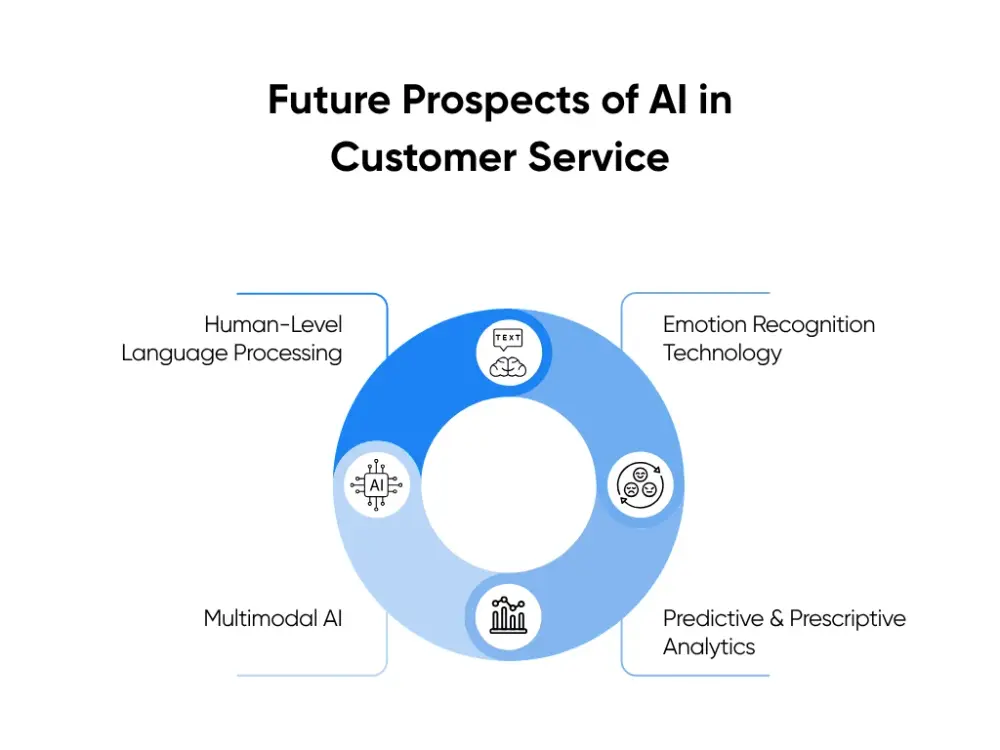
The future of customer service AI promises even more groundbreaking changes, driven by significant strides in AI’s capability to understand customer sentiment and relevant data like purchase history in a more contextualized and human-like manner.
Human-Level Language Processing
Human language processing continues advancing rapidly, approaching lifelike understanding of context, emotion, and nuance. By 2026, AI will conduct voice conversations indistinguishable from human agents, opening new possibilities for phone-based support that matches chat efficiency.
Emotion Recognition Technology
Current emotion recognition systems already achieve 95% accuracy in detecting customer emotions through text analysis, and voice emotion recognition is rapidly improving. Fully developed, this capability will enable AI to adjust responses dynamically based on customer mood, escalating to human agents when frustration is detected or celebrating with customers during positive interactions. The result will be more empathetic, emotionally intelligent automated support that maintains human connection despite being AI-powered.
Predictive and Prescriptive Analytics
This will help businesses identify potential issues before customers experience them, triggering preemptive outreach with solutions. Imagine your internet provider contacting you about a developing network issue before you notice slowdowns, or your bank alerting you to optimize your accounts based on spending patterns. This proactive approach will reduce support volume while dramatically improving customer satisfaction.
Multimodal AI
With multimodal AI, customers can show problems via photo or video while receiving interactive voice responses and visual guides for solutions. Voice, text, and visual inputs will fluently combine, allowing customers to communicate naturally while AI understands and responds appropriately across all channels. Once it matures, multimodal AI will also be instrumental for augmented reality, which can enable virtual technicians to guide customers through complex procedures.
You can stay abreast of the latest developments in business AI by subscribing to Aloa's AI newsletter for the latest insights, strategies, and case studies on implementing AI in customer service. Stay ahead of the curve with expert analysis of emerging technologies and practical guidance for leveraging AI to transform your customer experience.
Conclusion
The benefits of AI in customer service are clear, measurable, and increasing by the day. From automating routine tasks and providing 24/7 support to enhancing personalization and reducing costs, artificial intelligence has become an essential tool for customer service applications, and not just because of the productivity benefits.
By leveraging the right blend of virtual agents and human customer service professionals, customer service becomes a significant asset to brand trust, rather than merely another cost center.
Want to harness the potential of AI for your customer service? Aloa specializes in helping businesses like yours implement AI solutions. Our AI development services align every implementation with your unique workflow and customer expectations. Contact us today to learn more!
FAQs
What are the main benefits of AI in customer service?
The primary benefits of AI in customer service include significant cost reduction (typically 30% or more), 24/7 availability without additional staffing costs, automated handling of routine inquiries, better personalization at scale, and increased agent productivity.
How does AI improve customer interaction and service delivery?
AI improves customer interactions by providing instant responses, eliminating wait times, and offering personalized solutions based on customer history and preferences. It ensures consistent service quality 24/7, enables omnichannel support experiences, and can detect customer emotions to adjust responses accordingly.
What are the challenges of implementing AI in customer service?
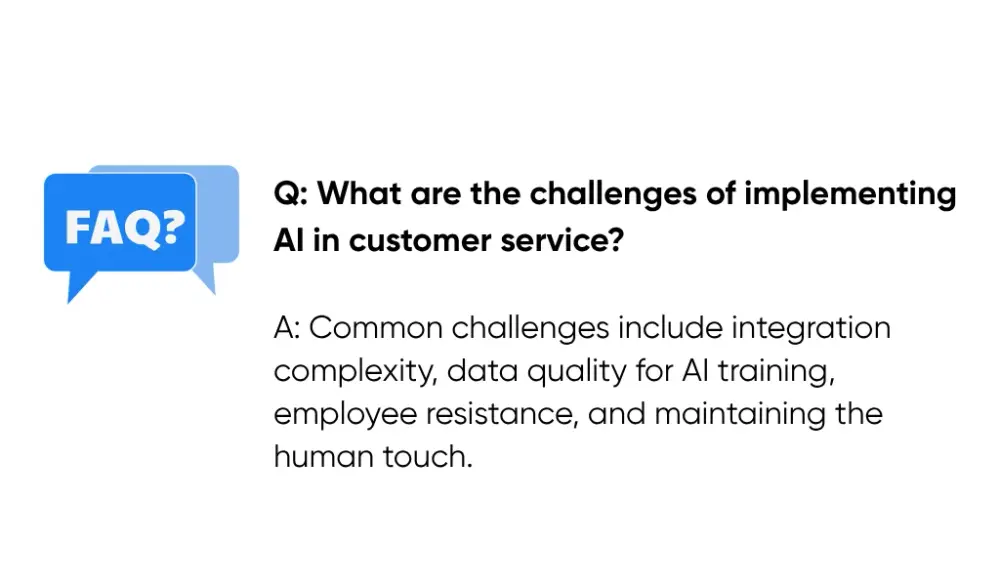
Common implementation challenges include integration complexity with existing systems, ensuring data quality for AI training, managing employee resistance to change, and maintaining the human touch in automated interactions.
How can businesses balance AI with human interaction in customer service?
AI should handle routine, repetitive tasks while humans manage complex, emotional, or high-value interactions. Implement smooth handoffs between AI and human agents, ensure AI knows when to escalate, and use AI to provide agents with context and suggestions during interactions.
What future trends in AI could impact customer service?
Emerging trends include emotion AI that adapts responses based on customer mood, voice AI achieving near-perfect accuracy for phone support, and multimodal AI combining text, voice, and visual interactions. Predictive analytics will enable proactive problem resolution before customers complain.